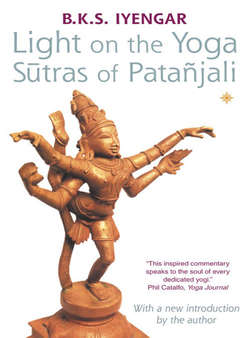Читать книгу Light on the Yoga Sutras of Patanjali - Литагент HarperCollins USD - Страница 17
Culture of consciousness
ОглавлениеThe culture of consciousness entails cultivation, observation, and progressive refinement of consciousness by means of yogic disciplines. After explaining the causes of fluctuations in consciousness, Patañjali shows how to overcome them, by means of practice, abhyasa, and detachment or renunciation, vairagya.
If the student is perplexed to find detachment and renunciation linked to practice so early in the Yoga Sutras, let him consider their symbolic relationship in this way. The text begins with atha yoganusAsanam. AnusAsanam stands for the practice of a disciplined code of yogic conduct, the observance of instructions for ethical action handed down by lineage and tradition. Ethical principles, translated from methodology into deeds, constitute practice. Now, read the word ‘renunciation’ in the context of sutra I.4: ‘At other times, the seer identifies with the fluctuating consciousness.’ Clearly, the fluctuating mind lures the seer outwards towards pastures of pleasure and valleys of pain, where enticement inevitably gives rise to attachment. When mind starts to drag the seer, as if by a stout rope, from the seat of being towards the gratification of appetite, only renunciation can intervene and save the sadhaka by cutting the rope. So we see, from sutras I.1 and I.4, the interdependence from the very beginning of practice and renunciation, without which practice will not bear fruit.
Abhyasa is a dedicated, unswerving, constant, and vigilant search into a chosen subject, pursued against all odds in the face of repeated failures, for indefinitely long periods of time. Vairagya is the cultivation of freedom from passion, abstention from worldly desires and appetites, and discrimination between the real and the unreal. It is the act of giving up all sensuous delights. Abhyasa builds confidence and refinement in the process of culturing the consciousness, whereas vairagya is the elimination of whatever hinders progress and refinement. Proficiency in vairagya develops the ability to free oneself from the fruits of action.
Patañjali speaks of attachment, non-attachment, and detachment. Detachment may be likened to the attitude of a doctor towards his patient. He treats the patient with the greatest care, skill and sense of responsibility, but does not become emotionally involved with him so as not to lose his faculty of reasoning and professional judgement.
A bird cannot fly with one wing. In the same way, we need the two wings of practice and renunciation to soar up to the zenith of Soul realization.
Practice implies a certain methodology, involving effort. It has to be followed uninterruptedly for a long time, with firm resolve, application, attention and devotion, to create a stable foundation for training the mind, intelligence, ego and consciousness.
Renunciation is discriminative discernment. It is the art of learning to be free from craving, both for worldly pleasures and for heavenly eminence. It involves training the mind and consciousness to be unmoved by desire and passion. One must learn to renounce objects and ideas which disturb and hinder one’s daily yogic practices. Then one has to cultivate non-attachment to the fruits of one’s labours.
If abhyasa and vairagya are assiduously observed, restraint of the mind becomes possible much more quickly. Then, one may explore what is beyond the mind, and taste the nectar of immortality, or Soul-realization. Temptations neither daunt nor haunt one who has this intensity of heart in practice and renunciation. If practice is slowed down, then the search for Soul-realization becomes clogged and bound in the wheel of time.
